Effect of Regulated Deficit Irrigation (RDI) on the Growth and Development of Pear Fruit (Pyrus communis L.), var. Triunfo de Viena
Abstract
:1. Introduction
2. Materials and Methods
2.1. Location
2.2. Response Variables
2.3. Analysis of Data
3. Results and Discussion
3.1. Production Parameters
3.2. Fruit Growth Rates
3.2.1. Absolute Growth Rate (AGR) of the Equatorial Fruit Diameter
3.2.2. Relative Growth Rate (RGR) of the Equatorial Fruit Diameter
3.2.3. Fruit and Stem Water Potential
4. Conclusions
Author Contributions
Funding
Institutional Review Board Statement
Informed Consent Statement
Data Availability Statement
Conflicts of Interest
References
- Konefal, J.; de Olde, E.M.; Hatanaka, M.; Oosterveer, P.J.M. Signs of agricultural sustainability: A global assessment of sustainability governance initiatives and their indicators in crop farming. Agric. Syst. 2023, 208, 103658. [Google Scholar] [CrossRef]
- Chartzoulakis, K.; Bertaki, M. Sustainable water management in agriculture under climate change. Agric. Agric. Sci. Procedia 2015, 4, 88–98. [Google Scholar] [CrossRef]
- Chai, Q.; Gan, Y.; Zhao, C.; Xu, H.-L.; Waskom, R.M.; Niu, Y.; Siddique, K.H.M. Regulated deficit irrigation for crop production under drought stress. A review. Agron. Sustain. Dev. 2016, 36, 3. [Google Scholar] [CrossRef]
- Benavides, H.O.; Simbaqueva, O.; Zapata, H.J. Atlas de Radiación Solar, Ultravioleta y Ozono de Colombia; Instituto de Hidrología, Meteorología y Estudios Ambientales (IDEAM): Bogota, Colombia, 2017; Available online: https://www.andi.com.co//Uploads/RADIACION.compressed.pdf (accessed on 17 June 2023).
- Yang, B.; Fu, P.; Lu, J.; Ma, F.; Sun, X.; Fang, Y. Regulated deficit irrigation: An effective way to solve the shortage of agricultural water for horticulture. Stress Biol. 2022, 2, 28. [Google Scholar] [CrossRef]
- Sotiropoulos, T.; Kalfountzos, D.; Aleksiou, I.; Kotsopoulos, S.; Koutinas, N. Response of a clingstone peach cultivar to regulated deficit irrigation. Sci. Agric. 2010, 67, 164–169. [Google Scholar] [CrossRef]
- Molina-Ochoa, M.J.; Vélez-Sánchez, J.E.; Rodríguez, P. Effect of regulated deficit irrigation on tree growth of pear cv. Triunfo de Viena. Agron. Colomb. 2015, 33, 330–338. [Google Scholar] [CrossRef]
- Salazar, C.; Hernández, C.; Pino, M.T. Plant water stress: Associations between ethylene and abscisic acid response. Chil. J. Agric. Res. 2015, 75 (Suppl. S1), 71–79. [Google Scholar] [CrossRef]
- Morandi, B.; Losciale, P.; Manfrini, L.; Zibordi, M.; Anconelli, S.; Galli, F.; Pierpaoli, E.; Corelli, L. Increasing water stress negatively effects pear fruit growth by reducing first its xylem and then its phloem inflow. J. Plant Physiol. 2014, 171, 1500–1509. [Google Scholar] [CrossRef]
- Gomes, V.H.F.; Simões, W.L.; da Silva, J.S.; Garrido, M.d.S.; da Silva, J.A.B.; Lopes, P.R.C.; da Silva, W.O.; dos Santos, L.R. Production, gas and biochemical exchanges in pear cultivated in semi-arid region under different irrigation managements. Braz. J. Agric. Environ. Eng. 2023, 27, 335–342. [Google Scholar] [CrossRef]
- Osakabe, Y.; Osakabe, K.; Shinozaki, K.; Tran, L.S.P. Response of plants to water stress. Front. Plant Sci. 2014, 5, 86. [Google Scholar] [CrossRef] [PubMed]
- Gasque, M.; Granero, B.; Turegano, J.V.; González-Altozano, P. Regulated deficit irrigation effects on yield, fruit quality and vegetative growth of “Navelina” citrus trees. Span. J. Agric. Res. 2010, 8, 40–51. [Google Scholar] [CrossRef]
- Vélez, J.; Intrigliolo, D.S.; Castel, J.R. Programación de riego en cítricos en base a sensores de medida del estado hídrico del suelo y de la planta. Rev. UDCA Act. Div. Cient. 2012, 14, 65–73. [Google Scholar] [CrossRef]
- Intrigliolo, D.S.; Castel, J.R. Performance of various water stress indicators for prediction of fruit size response to deficit irrigation in plum. Agric. Water Manag. 2006, 83, 173–180. [Google Scholar] [CrossRef]
- Vélez, J.; Álvarez-Herrera, J. Riego en Frutales. In Manual Para el Cultivo de Frutales en el Trópico; Fischer, G., Ed.; Editorial Produmedios: Bogota, Colombia, 2012; pp. 186–214. [Google Scholar]
- López, G.; Larrigaudiére, C.; Girona, J.; Behboudian, M.H.; Marsal, J. Fruit thinning in ‘Conference’ pear grown under deficit irrigation: Implications for fruit quality at harvest and after cold storage. Sci. Hortic. 2011, 129, 64–70. [Google Scholar] [CrossRef]
- Vélez, J.; Balaguera, H.; Álvarez, J. Effect of regulated deficit irrigation (RDI) on the production and quality of pear Triunfo de Viena variety under tropical conditions. Sci. Hortic. 2021, 278, 109880. [Google Scholar] [CrossRef]
- Campos, T.J. Especies y variedades de hoja caduca en Colombia. In Los Frutales Caducifolios en Colombia; Miranda, D., Fischer, G., Carranza, C., Eds.; Sociedad Colombiana de Ciencias Hortícolas: Bogota, Colombia, 2013; pp. 47–65. [Google Scholar]
- Casierra-Posada, F. Manzano y peral (Malus domestica Borkh.)–(Pyrus communis L.). In Manual Para el Cultivo de Frutales en el Trópico; Fischer, G., Ed.; Produmedios: Bogota, Colombia, 2012; pp. 657–681. [Google Scholar]
- Agronet. Área, Producción y Rendimiento Nacional por Cultivo. Available online: https://agronet.gov.co/estadistica/Paginas/home.aspx?cod=1 (accessed on 17 August 2023).
- Fernandes de Oliveira, A.; Mameli, M.G.; De Pau, L.; Satta, D. Almond tree adaptation to water stress: Differences in physiological performance and yield responses among four cultivars grown in Mediterranean environment. Plants 2023, 12, 1131. [Google Scholar] [CrossRef] [PubMed]
- Instituto Geográfico Agustín Codazzi (IGAC). Clasificación de Suelos en el Departamento de Cundinamarca; Departamento Nacional de Estadística, subdirección de Agrología and Universidad Tecnológico y Pedagógica de Colombia: Bogota, Colombia, 2010; Volume 169, pp. 325–327. [Google Scholar]
- Allen, R.G.; Pereira, L.S.; Raes, D.; Smith, M. Crop Evapotranspiration, Guidelines for Computing Crop Water Requirements-FAO Irrigation and Drainage Paper 56; FAO: Rome, Italy, 1998. [Google Scholar]
- Cleves-Leguizamo, J.A.; Toro-Calderón, J.; Martínez-Bernal, L. Los balances hídricos agrícolas en modelos de simulación agroclimáticos. Una revisión analítica. Rev. Colomb. Cienc. Hortic. 2016, 10, 149–163. [Google Scholar] [CrossRef]
- Doorenbos, J.; Pruitt, W. Las Necesidades de Agua de los Cultivos; Estudio FAO Riego y Drenaje 24; FAO: Rome, Italy, 1986. [Google Scholar]
- Scholander, P.F.; Hammel, H.T.; Bradstreet, E.D.; Hemmingsen, E.A. Sap presure in vascular plants. Science 1965, 184, 339–346. [Google Scholar] [CrossRef] [PubMed]
- Hsiao, T.C. Measurements of plant water status. In Irrigation of Agricultural Crops; Steward, B.A., Nielsen, D.R., Eds.; American Society of Agronomy: Madison, WI, USA, 1990; pp. 243–279. [Google Scholar]
- Marsal, J.; López, G.; Mata, M.; Girona, J. Postharvest deficit irrigation in “Conference” pear: Effects on subsequent yield and fruit quality. Agric. Water Manag. 2012, 103, 1–7. [Google Scholar] [CrossRef]
- Molina-Ochoa, M.J.; Vélez, J.E.; Galindo, A. Resultados preliminares del efecto del riego deficitario durante el periodo de crecimiento rápido del fruto de pera (var. Triunfo de Viena) en la producción y calidad del fruto. Rev. Colomb. Cienc. Hortic. 2015, 9, 38–45. [Google Scholar] [CrossRef]
- Zhao, Z.; Wang, W.; Wu, Y.; Xu, M.; Huang, X.; Ma, Y.; Ren, D. Leaf physiological responses of mature pear trees to regulated deficit irrigation in field conditions under desert climate. Sci. Hortic. 2015, 187, 122–130. [Google Scholar] [CrossRef]
- Díaz, D.; Vélez, J.; Rodríguez, P. Efecto de la aplicación de riego controlado en la producción y calidad del fruto de Pyrus communis L., cv. Triunfo de Viena. Acta Agron. 2016, 65, 156–163. [Google Scholar] [CrossRef]
- Vélez, J.; Polania, W.; Beltrán, N. Effect of irrigation regime on the production of volatiles that affect the aroma of the pear variety Triumph of Vienna (Pyrus communis L.). Rev. Colomb. Cienc. Hortic. 2019, 13, 348–358. [Google Scholar] [CrossRef]
- Goldhamer, D.A. Regulated deficit irrigation in trees and vines. In Agricultural Water Management, Proceedings of a Workshop in Tunisia; The National Academies Press: Washington, DC, USA, 2007; pp. 70–80. [Google Scholar] [CrossRef]
- Ningbo, C.; Taisheng, D.; Shaozhong, K.; Fusheng, L.; Jianhua, Z.; Mixia, W.; Zhijun, L. Regulated deficit irrigation improved fruit quality and water use efficiency of pear-jujube trees. Agric. Water Manag. 2008, 95, 489–497. [Google Scholar] [CrossRef]
- Vélez, J.; Intrigliolo, D.S.; Castel, J.R. Scheduling deficit irrigation of citrus trees with maximum daily trunk shrinkage. Agric. Water Manag. 2007, 90, 197–204. [Google Scholar] [CrossRef]
- Molina-Ochoa, M.J.; Vélez, J.E.; Rodríguez, P. Efecto del riego deficitario controlado en las tasas de crecimiento del fruto de pera (Pyrus communis L.) var. Triunfo de Viena. Rev. Colomb. Cienc. Hortic. 2015, 9, 234–246. [Google Scholar] [CrossRef]
- Chalmers, D.J.; Burge, G.; Jerie, P.H.; Mitchell, P.D. The mechanism of regulation of ‘Bartlett’ pear fruit and vegetative growth by irrigation withholding and regulated deficit irrigation. J. Am. Soc. Hortic. Sci. 1986, 111, 904–907. [Google Scholar] [CrossRef]
- Garriz, P.I.; Colavita, G.M.; Alvarez, H.L.; Spera, N.; Blackhall, V. A model for predicting diameter of ‘Red Sensation’ pears. Acta Hortic. 2015, 1068, 147–152. [Google Scholar] [CrossRef]
- Ribeiro, T.D.; Savian, T.V.; Fernandes, T.J.; Muniz, J.A. The use of the nonlinear models in the growth of pears of ‘Shinseiki’ cultivar. Ciência Rural 2018, 48, 1–7. [Google Scholar] [CrossRef]
- Pérez-Pastor, A.; Ruiz-Sánchez, M.C.; Domingo, R. Effects of timing and intensity of deficit irrigation on vegetative and fruit growth of apricot trees. Agric. Water Manag. 2014, 134, 110–118. [Google Scholar] [CrossRef]
- de Oliveira, C.M.; Simões, W.L.; Lopes, P.R.C.; da Silva, J.B.; Araujo, E.F.; Cavalcante, B.L.S. Flowering, fruiting and physiology of apple tree under different irrigation levels in the Brazilian semiarid region. Comun. Sci. 2017, 8, 99–108. [Google Scholar] [CrossRef]
- Scharwies, J.D.; Grimm, E.; Knoche, M. Russeting and relative growth rate are positively related in ‘Conference’ and ‘Condo’ Pear. HortScience 2014, 49, 746–749. [Google Scholar] [CrossRef]
- Dell’Amico, J.; Domingo, R.; Pérez, M.; García, M.; Peñalver, M.; Villanueva, F.; Puerto, P. Water relations and ion content of mandarin plants cv ‘Fortune’ within a drought and recovery cycle of the fast fruit growth stage. Cult. Trop. 2011, 32, 30–41. [Google Scholar]
- Vélez, J.; Balaguera, H.; Rodríguez, P. The water status of pear (Pyrus communis L.) under application of regulated deficit irrigation in high tropical latitudinal conditions. J. Saudi Soc. Agric. Sci. 2022, 21, 460–468. [Google Scholar] [CrossRef]

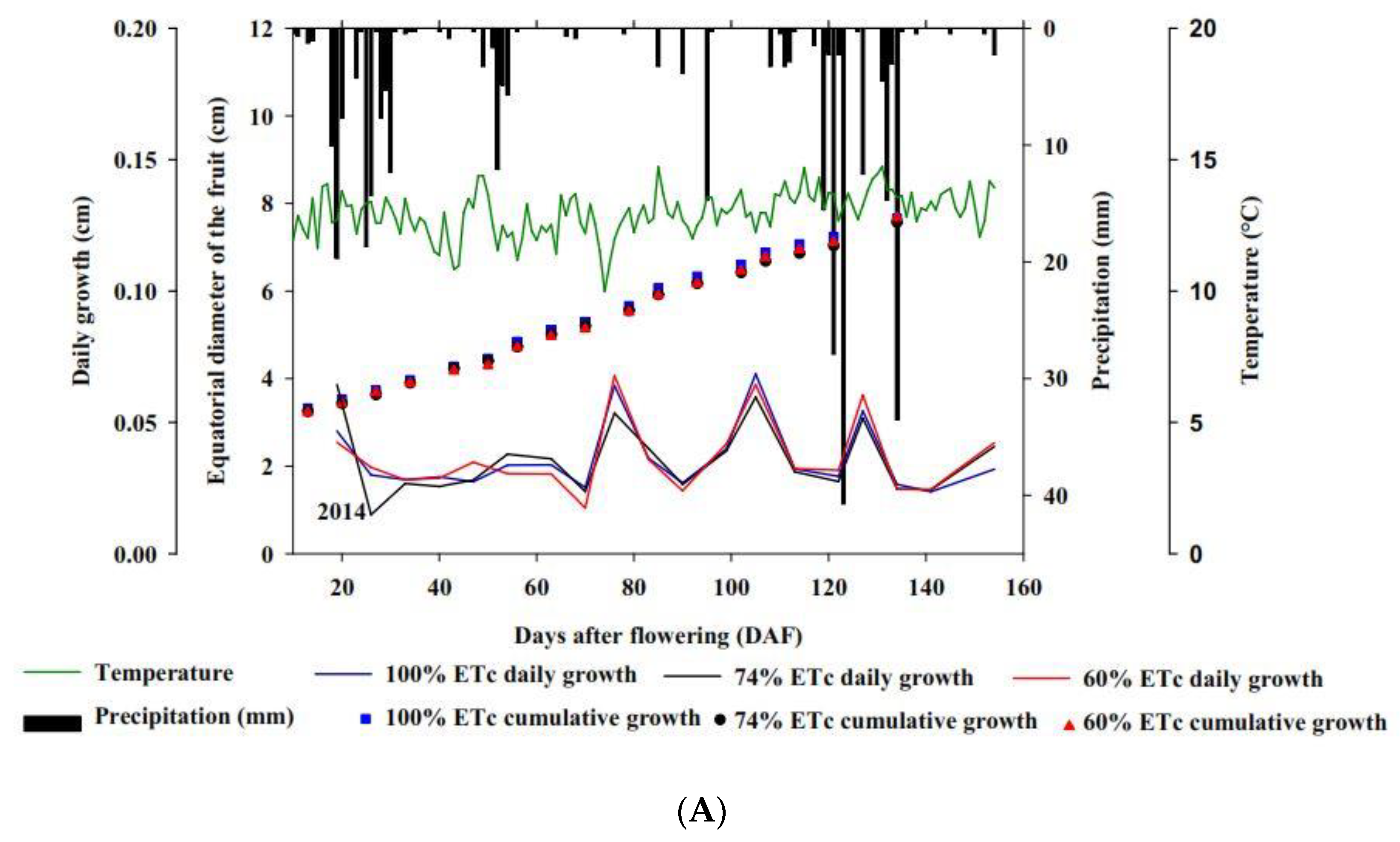
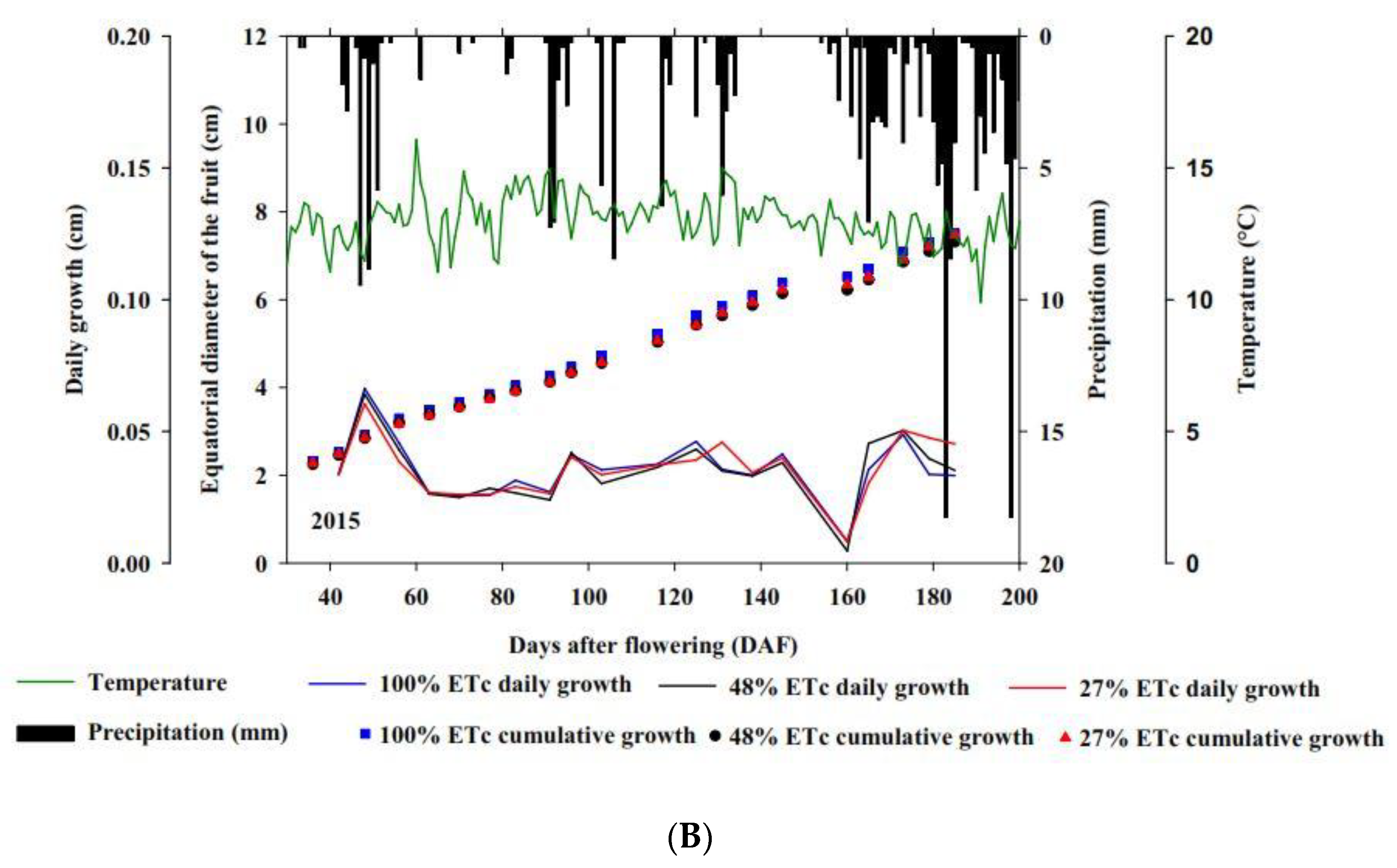
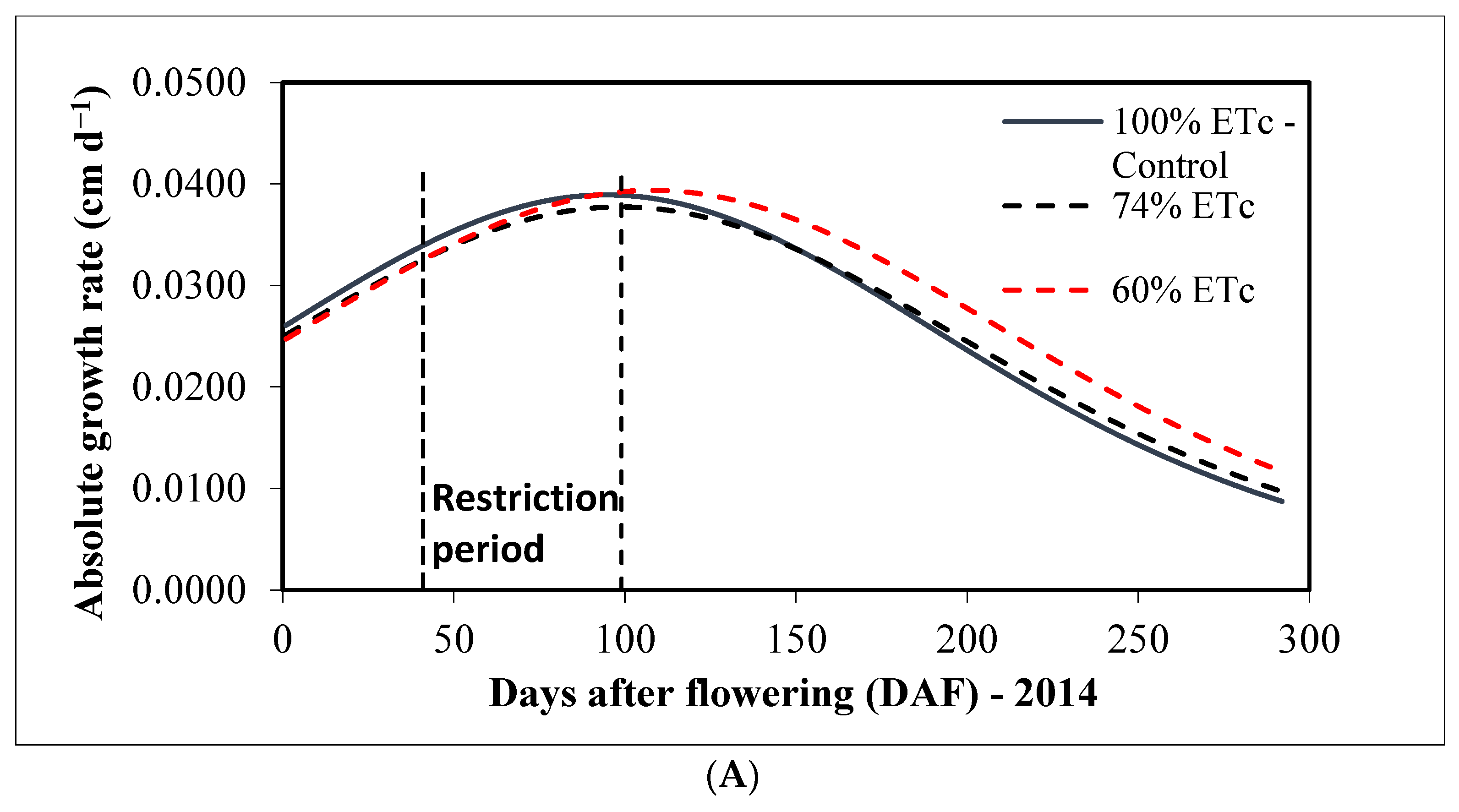
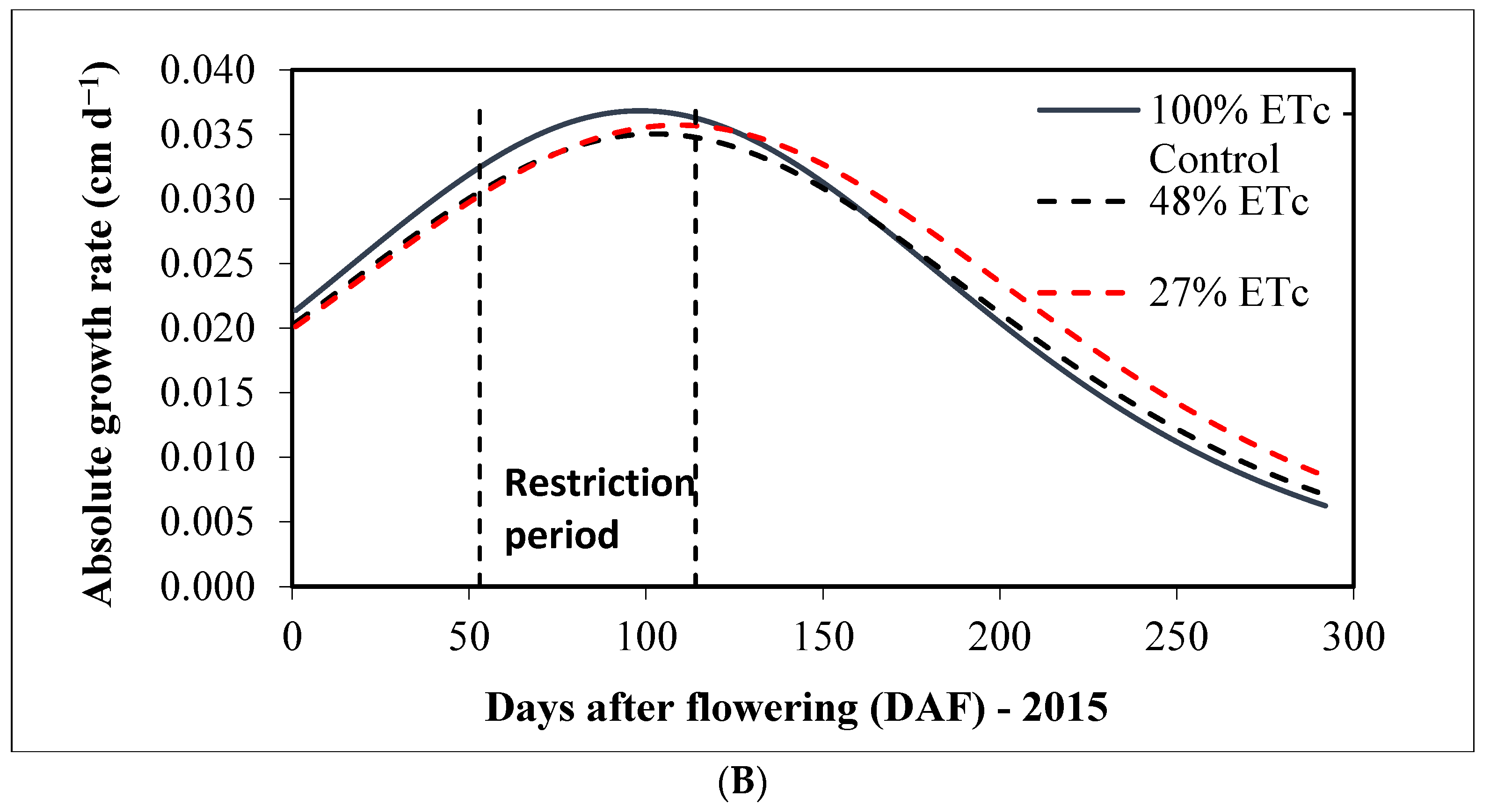
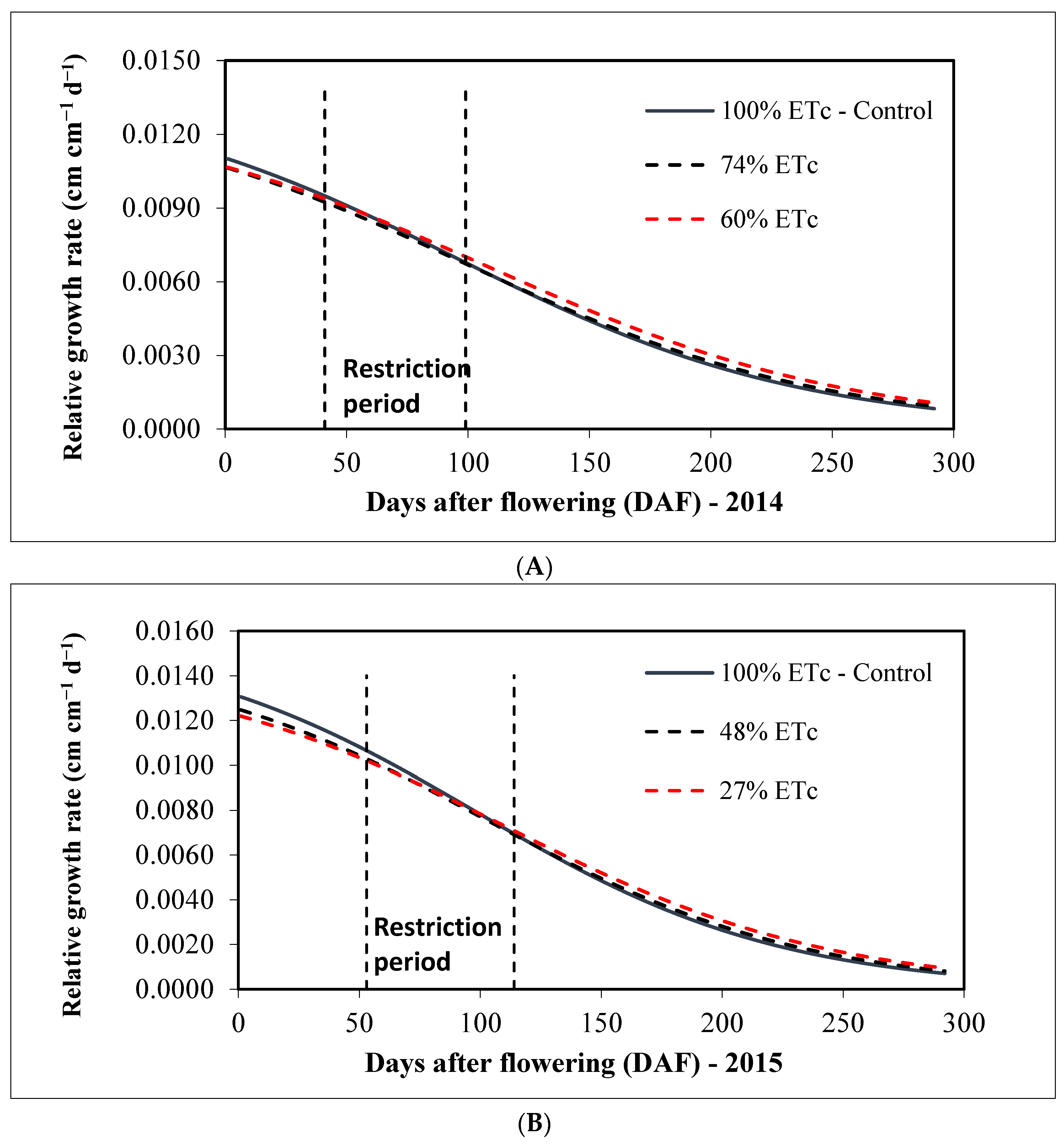
| Year | Treatment | Fresh Weight (g) | Dry Weight (g) | Dry Weight (%) |
|---|---|---|---|---|
| 2014 | 100% ETc | 291.93 a (LSD 44.80) | 37.52 a (LSD 5.31) | 12.85 a (LSD 1.30) |
| 74% ETc | 305.36 a | 38.88 a | 12.73 a | |
| 60% ETc | 267.04 a | 34.88 a | 13.06 a | |
| 2015 | 100% ETc | 167.99 a * (LSD 21.13) | 26.64 a * (LSD 2.79) | 15.86 a * (LSD 2.19) |
| 48% ETc | 173.18 a * | 25.67 a * | 14.82 a * | |
| 27% ETc | 163.74 a * (LSD* 19.88) | 24.02 a * (LSD* 2.40) | 14.67 a * (LSD* 1.01) |
| Year | Treatment | Production (kg/tree) | Average Fruit Weight 1 (g) | Number of Fruits per Tree | Number of Fruits Category I 2 | Number of Fruits Category II 3 | Number of Fruits Category III 4 |
|---|---|---|---|---|---|---|---|
| 2014 | 100% ETc | 275.05 a (LSD 181.54) | 215.07 a (LSD 35.22) | 1267 a (LSD 701.87) | 444 a (LSD 262.92) | 478 a (LSD 282.3) | 345 a (LSD 189.18) |
| 74% ETc | 240.35 a | 210.32 a | 1135 a | 424 a | 433 a | 278 a | |
| 60% ETc | 272.76 a | 244.16 a | 1094 a | 401 a | 384 a | 309 a | |
| 2015 | 100% ETc | 194.45 a * (LSD 79.34) | 176.54 a * (LSD 22.90) | 1111 a (LSD 486.36) | 545 a (LSD 298.78) | 407 a (LSD 182.14) | 159 a * (LSD 104.68) |
| 48% ETc | 192.36 a | 163.73 a * | 1179 a | 600 a * | 415 a | 164 a * | |
| 27% ETc | 184.35 a * (LSD* 71.22) | 162.83 a * (LSD* 17.32) | 1133 a (LSD* 308.06) | 489 a (LSD* 143.29) | 443 a (LSD* 122.56) | 201 a * (LSD* 78.95) |
| Year | Treatment | a | b | c | R2 |
|---|---|---|---|---|---|
| 2014 | 100% ETc | 11.141 | 71.560 | 94.630 | 0.998 |
| 74% ETc | 11.202 | 74.210 | 98.820 | 0.998 | |
| 60% ETc | 11.896 | 75.540 | 108.030 | 0.998 | |
| 2015 | 100% ETc | 9.295 | 63.100 | 98.350 | 0.995 |
| 48% ETc | 9.247 | 65.980 | 102.350 | 0.994 | |
| 27% ETc | 9.729 | 68.100 | 109.130 | 0.995 |
| Treatment | Ψfd (MPa) | Ψfn (MPa) |
|---|---|---|
| 100% ETc | −0.43 to −0.52 | −1.19 to −1.33 |
| 74% ETc | −0.36 to −0.51 | −1.19 to −1.37 |
| 60% ETc | −0.42 to −0.51 | −1.12 to −1.49 |
Disclaimer/Publisher’s Note: The statements, opinions and data contained in all publications are solely those of the individual author(s) and contributor(s) and not of MDPI and/or the editor(s). MDPI and/or the editor(s) disclaim responsibility for any injury to people or property resulting from any ideas, methods, instructions or products referred to in the content. |
© 2023 by the authors. Licensee MDPI, Basel, Switzerland. This article is an open access article distributed under the terms and conditions of the Creative Commons Attribution (CC BY) license (https://creativecommons.org/licenses/by/4.0/).
Share and Cite
Vélez-Sánchez, J.; Casierra-Posada, F.; Fischer, G. Effect of Regulated Deficit Irrigation (RDI) on the Growth and Development of Pear Fruit (Pyrus communis L.), var. Triunfo de Viena. Sustainability 2023, 15, 13392. https://doi.org/10.3390/su151813392
Vélez-Sánchez J, Casierra-Posada F, Fischer G. Effect of Regulated Deficit Irrigation (RDI) on the Growth and Development of Pear Fruit (Pyrus communis L.), var. Triunfo de Viena. Sustainability. 2023; 15(18):13392. https://doi.org/10.3390/su151813392
Chicago/Turabian StyleVélez-Sánchez, Javier, Fánor Casierra-Posada, and Gerhard Fischer. 2023. "Effect of Regulated Deficit Irrigation (RDI) on the Growth and Development of Pear Fruit (Pyrus communis L.), var. Triunfo de Viena" Sustainability 15, no. 18: 13392. https://doi.org/10.3390/su151813392






